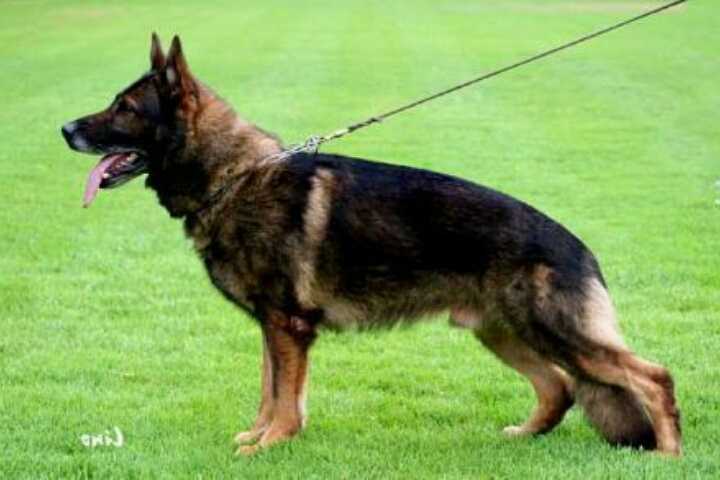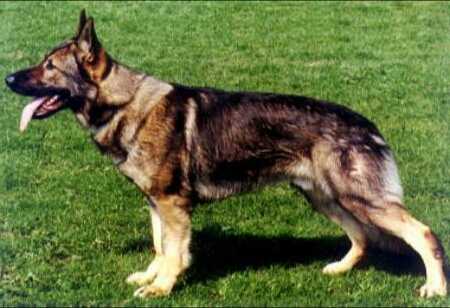
This is a placeholder text
Group text
by Abby Normal on 12 June 2011 - 19:06
here is a link to the report published in SV mag. Unless you speak fluent German or know someone who does though, it is hard going.
http://www.schaeferhunde.de/site/fileadmin/pdf/presseinfo/2010/SVZTG_05-2010a.pdf
BTW love the image of the Cairn terrier. Always thought they were feisty little wolf like dogs. I've always nicknamed them mini werewolves. The whole point though - shape of back.
BTW I have honestly never seen a WL with a roach back, can you point me to one?
by Brittany on 12 June 2011 - 20:06
I seen a WL with bad roach back here on the advertisement section. I can't seem to be able to find it anymore. Not sure if the owner took it down or what.
Here's a WL with a bow back.
SG Ellute von der Mohnwiese born 1998

The back has more of a bow then a typical straight back. Beautiful dog thought. The back could be straight.
Look at the difference with his father
Tom van't Leefdaalhof born on 1995

The back is straight.
by apoArmani on 12 June 2011 - 20:06
Also the length and lay of croup...these are major factors in the two pictures provided and the immage they portray in differences of the two dogs!
In my humble opinion, the problem with the excentuated top-lines is a result of bad or incorrect under-lines, and when a puppy grows with these faults added with a flatish,short wither, and with poor forequarters - then over the growth-months, where the puppy continues to trot and galop with this structure; the bottom-line (the length and its relationship with the top-line)...tend to push UP-WORD, hence making the distortion of the top-line a permanent part of the body!
by VKGSDs on 12 June 2011 - 21:06
Even without comparison I would like to see an x-ray of the entire spine of a modern day SL GSD.
This is not the *entire* spine, but this is the spine of the dog pictured below (a type-y west German show line dog). Click on it for a bigger version. It should be noted that this dog has at least one extra transitional vertebrae which has caused a lot of problems with asymmetry in the pelvic structures (though the hip sockets themselves are fine, dog is OFA Good and cannot even be positioned correctly because of the asymmetry). I have no idea how the dog was positioned for the spine x-ray, we just were doing others and figured we might as well check the spine. Not sure if this is what you are looking for...



by Abby Normal on 12 June 2011 - 22:06
Thank you for that. It is really very interesting, as the dog pictured does not have a particularly rounded outline, not what I would call exaggerated in SL. What I would call a 'straighter' back than many. The X ray of the spine does show obvious curvature. I wonder does the apex of the curve correspond with the area just beyond the middle of the spine from wither to croup which is what I would anticipate looking at the actual dog? The evidence of TVS is interesting and I know was covered in the German study.
Are there any orthopaedic specialists here that could comment?
I would love to compare that to a WL with a straight back, anyone have an x-ray? I say this because no spine is *straight* as such, so I think the comparison would be needed to be able to highlight significant differences. Also although we don't know what the positioning was for the x-ray, I guess one can assume that the dog was set out in a position which would be natural to the spine (straight) to get a clean view. Again thank you for sharing that. It would be very interesting if anyone else has any spinal x rays to compare.
by VKGSDs on 12 June 2011 - 22:06
Does the spine x-ray tell you anything? I have no clue how to "read" it. It seems like we couldn't really say whether or not the dog's back is curved unless the x-ray was positioned to match how the dog stands/stacks naturally? Like, what if someone x-rayed a dog's spine while the dog was curled into a ball and then said "oh look his spine is terribly curved!"
The reason why I had that dog's spine x-rayed was because we were trying to diagnose a very very slight limp and dragging of the right hind foot at very slow paces (if the dog starts trotting or anything faster, all abnormal movement disappears). I figured to start ruling out the easiest and/or most common problems first, starting with HD so I waited for 24 months for a second set of films and told the vet he could do the spine if he felt that would be helpful. When I went to pick up my dog the first film I saw was the spine which made me feel relived that there was no HD (vet would not have done the spine if the cause was obvious on the hip film) but also not so good because it meant the problem was caused by something else. Turns out the TVS/APA are pretty bad. Right now my dog moves with a more obvious limp on the right side, there's a pretty noticeable popping sound as he moves (when he's out in the yard I can hear it in my den), he still drags the right foot, and just recently I noticed that when I flip the right foot over so the toes are unnaturally curled under, he no longer corrects it (usually a dog will flip the foot back almost reflexively). So, the dog in that film *does* have somewhat of a back problem but the problems are being caused by the extra vertebrae that have all these weird bony spurs.
My working line will probably have his spine x-rayed as well when he gets his two year old films for OFA (he's only 10 months).
by Sunsilver on 13 June 2011 - 01:06
Rolf v. Osnabrucker Land produced a lot of progeny with weak backs that had a dip in them. Some definitely appeared swaybacked, and part of what happened in the Martin era was as a result of efforts to correct this problem.
If the roach back is stronger than the flat back, how come wild canids (wolves, coyotes, etc.) have back that are more or less flat?
I hate the roach back and think nature knows best.
And as for 'form follows function'...excuse me, but BULLS**T!!!
http://terriermandotcom.blogspot.com/2009/08/counterfeit-collies-and-transvestite.html
Form is about form. Function is about function. At best there is a relationship when it come to gross body shape or size, but that's not what they are judging at the dog shows is it? Instead, the most minute and insignificant detail is elevated to importance by preening pretenders and a handful of people doing contrived "work."
And what is the result?
It can be seen in breed after show-ring breed: transvestite terriers, counterfeit collies, and bogus bulldogs. The dogs may look the part, but they cannot do the job.
The Saint Bernard has been reduced to such dysplastic dysfunction that the dog cannot hope to rescue anything. In fact, it is an animal that needs to be rescued!
And let's not even start with the show-line German Shepherd, with hocks so sprung it looks like a dog sired by a frog.
Here is a simple truth: you cannot protect and preserve working dogs without working them.
As for the breed standard (as someone else pointed out already) :
It is all laughable nonsense. And it becomes nonsense on stilts when people begin to talk about "the standard" as if it were a sacred text delivered to Moses on the Mount.
In fact, is there anything standard about "the standard?" I defy you to find a single canine standard that is more than 20 years old that has not been changed at least once.
And then there is the little matter that the standard is not the same from one country to another, or one registry to another. So what is so "standard" about the standard?
by trixx on 13 June 2011 - 03:06
i have showlines and i have very straight back dogs and prefer this type of body style, here is a pic of one of my females..jpg)
she is 7 and never had any problems, so i know there are some good back showlines, just not alot of them.
by Ruger1 on 13 June 2011 - 04:06
My WG showline has a perfectly beautiful back....: )
by hexe on 13 June 2011 - 05:06
Has there been any change to the spine of the show-line GSDs which display the 'arched' topline? Quite possibly, although as someone else pointed out, you also have to factor in angulation in the forehand and hindquarters, along with length of torso, in some instances because these, too, will play a role in the appearance of the topline. Regardless of the cause of the change, I'm also firmly in the camp that finds this trend of extreme arch to the topline to be horrid.
VKGSD, I recall seeing your recent post about the situation with your dog, but didn't respond because there's not much to say that you haven't already learned (and did so the hard way, unfortunately, via having an affected dog). Given your description of the dog's present movement issues, it sounds like you probably should be stashing away the $$ for surgery to correct cauda equina, because you're already seeing the clinical signs of nerve compression--but once that's successfully corrected, the dog should be able to enjoy a normal active lifestyle.
Sunsilver, re the retort regarding the old adage, "Form follows function", it's NOT "BULLS**T!!!" Form most certainly DOES follow function, so long as one is actually using FUNCTION to make the breeding selections. The problem with most purebred dogs is very few are engaged in doing the functions that brought about their original phenotype in the first place. For all that the modern HGH is disparaged by some as being too easy, at least it still does give the opportunity to see if the dog is physically capable of doing the work when properly physically conditioned.
Contact information Disclaimer Privacy Statement Copyright Information Terms of Service Cookie policy ↑ Back to top




